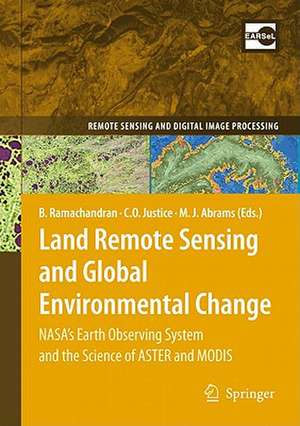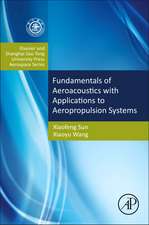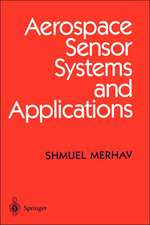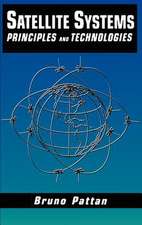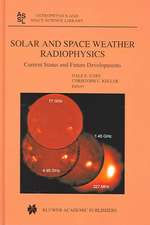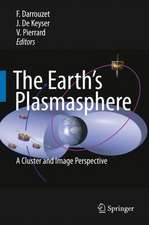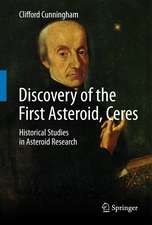Land Remote Sensing and Global Environmental Change: NASA's Earth Observing System and the Science of ASTER and MODIS: Remote Sensing and Digital Image Processing, cartea 11
Editat de Bhaskar Ramachandran, Christopher O. Justice, Michael J. Abramsen Limba Engleză Hardback – 8 noi 2010
| Toate formatele și edițiile | Preț | Express |
|---|---|---|
| Paperback (1) | 1587.37 lei 38-44 zile | |
| Springer – 23 aug 2016 | 1587.37 lei 38-44 zile | |
| Hardback (1) | 1613.59 lei 38-44 zile | |
| Springer – 8 noi 2010 | 1613.59 lei 38-44 zile |
Din seria Remote Sensing and Digital Image Processing
- 18%
 Preț: 1020.74 lei
Preț: 1020.74 lei - 18%
 Preț: 1231.47 lei
Preț: 1231.47 lei - 18%
 Preț: 944.82 lei
Preț: 944.82 lei - 15%
 Preț: 530.42 lei
Preț: 530.42 lei - 18%
 Preț: 1385.19 lei
Preț: 1385.19 lei - 24%
 Preț: 793.38 lei
Preț: 793.38 lei - 15%
 Preț: 640.37 lei
Preț: 640.37 lei - 18%
 Preț: 1112.15 lei
Preț: 1112.15 lei - 18%
 Preț: 1408.08 lei
Preț: 1408.08 lei - 15%
 Preț: 662.95 lei
Preț: 662.95 lei - 18%
 Preț: 954.45 lei
Preț: 954.45 lei - 18%
 Preț: 1389.78 lei
Preț: 1389.78 lei - 24%
 Preț: 1476.65 lei
Preț: 1476.65 lei - 18%
 Preț: 1122.10 lei
Preț: 1122.10 lei - 18%
 Preț: 1407.64 lei
Preț: 1407.64 lei - 20%
 Preț: 988.28 lei
Preț: 988.28 lei - 18%
 Preț: 945.76 lei
Preț: 945.76 lei - 24%
 Preț: 802.76 lei
Preț: 802.76 lei - 15%
 Preț: 650.86 lei
Preț: 650.86 lei - 15%
 Preț: 650.37 lei
Preț: 650.37 lei - 15%
 Preț: 642.51 lei
Preț: 642.51 lei - 15%
 Preț: 653.46 lei
Preț: 653.46 lei
Preț: 1613.59 lei
Preț vechi: 2123.14 lei
-24% Nou
Puncte Express: 2420
Preț estimativ în valută:
308.86€ • 335.60$ • 259.61£
308.86€ • 335.60$ • 259.61£
Carte tipărită la comandă
Livrare economică 16-22 aprilie
Preluare comenzi: 021 569.72.76
Specificații
ISBN-13: 9781441967480
ISBN-10: 1441967486
Pagini: 873
Ilustrații: XLII, 873 p.
Dimensiuni: 155 x 235 x 41 mm
Greutate: 1.66 kg
Ediția:2011
Editura: Springer
Colecția Springer
Seria Remote Sensing and Digital Image Processing
Locul publicării:New York, NY, United States
ISBN-10: 1441967486
Pagini: 873
Ilustrații: XLII, 873 p.
Dimensiuni: 155 x 235 x 41 mm
Greutate: 1.66 kg
Ediția:2011
Editura: Springer
Colecția Springer
Seria Remote Sensing and Digital Image Processing
Locul publicării:New York, NY, United States
Public țintă
ResearchCuprins
Prologue.- Acknowledgments.- Part I: The Earth Observing System and the Evolution of ASTER and MODIS.- Part II: ASTER and MODIS: Instrument Design, Radiometry and Geometry.- Part III: ASTER and MODIS: Data Systems.- Part IV: ASTER Science and Applications.- Part V: MODIS Science and Applications.- Part VI: The Future of Land Remote Sensing.- Index.
Recenzii
From the reviews:
“This book is directed to those involved in monitoring land surfaces using remotely sensed data … . provides a solid reference to the current science and application of the ASTER and MODIS sensors. This book encompasses both the technical aspects and the wide range of applications of both sensors. … provides an excellent reference for the technical specifications and consideration in these sensors. … Those who use ASTER or MODIS imagery for land observations should consider finding room on their bookshelves for this book.” (Anthony L. Nguy-Robertson, Photogrammetric Engineering & Remote Sensing, January, 2012)
“This book is directed to those involved in monitoring land surfaces using remotely sensed data … . provides a solid reference to the current science and application of the ASTER and MODIS sensors. This book encompasses both the technical aspects and the wide range of applications of both sensors. … provides an excellent reference for the technical specifications and consideration in these sensors. … Those who use ASTER or MODIS imagery for land observations should consider finding room on their bookshelves for this book.” (Anthony L. Nguy-Robertson, Photogrammetric Engineering & Remote Sensing, January, 2012)
Notă biografică
Bhaskar Ramachandran is a senior scientist who supports the NASA Earth Observing System (EOS) science mission at the Earth Resources and Observation Science (EROS) Center at the U.S. Geological Survey in Sioux Falls, South Dakota. He currently supports the MODIS science mission, and has performed similar roles for the Landsat-7 and ASTER missions in the past. His current research interests include the use of semantic web capabilities, and building ontologies to represent geospatial science knowledge domains. Chris Justice is a Professor and Research Director at the Geography Department of the University of Maryland. He is the land discipline chair for the NASA MODIS Science Team and is responsible for the MODIS Fire Product. He is a member of the NASA NPOESS Preparatory Project (NPP) Science Team. He is the NASA Land Cover Land Use Change Program Scientist. His current research is on land cover and land use change, the extent and impacts of global fire, global agricultural monitoring,and their associated information technology and decision support systems. Michael Abrams received his degrees in Biology and Geology from the California Institute of Technology. Since 1973 he has worked at NASA's Jet Propulsion Laboratory in geologic remote sensing. He served on the science team for many instruments, including Skylab, HCMM, Landsat, and EO-1. Areas of specialization are mineral exploration, natural hazards, volcanology, and instrument validation. He has been on the US/Japan ASTER Science Team since 1988, and became the ASTER Science Team Leader in 2003.
Textul de pe ultima copertă
Global environmental change remains a constant theme that resonates worldwide. The dynamics of the Earth system fosters complex spatio-temporal variations that highlight the significance of, and the need to monitor the Earth as a unified whole. Accurate, timely, and reliable data are a precursor to analyze and study several aspects of the integrated Earth system. Remote sensing observations have catalyzed several aspects of Earth system science by providing panoptic views and time-series measurements of the study environment in ways nearly impossible to replicate by traditional ground-based methods. NASA’s Earth Observing System’s (EOS) primary goal is to study and understand all interacting components of the Earth as a dynamic system. Land Remote Sensing and Global Environmental Change is an edited compendium that specifically focuses on the terrestrial components of change based on the scientific knowledge derived from data produced by two EOS instruments, ASTER and MODIS,which are part of the Terra and Aqua satellite missions. As global environmental change in the Anthropocene age becomes more ubiquitous, the papers presented in this volume demonstrate the value of EOS for studying the Earth’s surface. This volume helps articulate the EOS mission as a rich synergistic confluence of science, engineering, and technology, which helps us decipher how our terrestrial systems both contribute and respond to global environmental change.
Audience: The primary audience for this book includes Earth and environmental science researchers and professionals, including those who use land remote sensing data.
Audience: The primary audience for this book includes Earth and environmental science researchers and professionals, including those who use land remote sensing data.
Caracteristici
The first comprehensive resource on ASTER and MODIS Provides a synoptic view of how systems engineering facilitates a complex and growing data and information management system Explores the philosophical and methodological aspects of passive optical remote sensing as they relate to studying global environmental change
